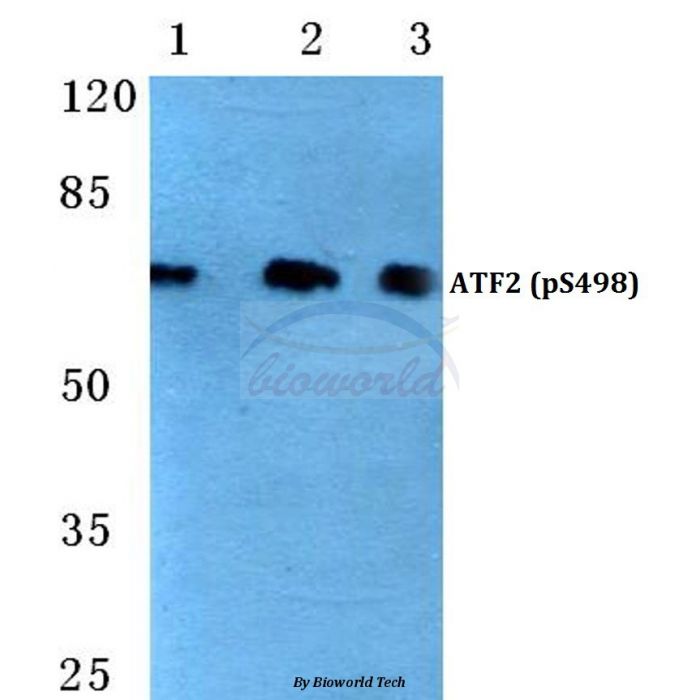ATF2 (phospho-S498) polyclonal, anti-human, mouse
€328.00
In stock
SKU
BS4654
Background:
The transcription factor ATF-2 (also called CRE-BP1) binds to both AP-1 and CRE DNA response elements and is a member of the ATF/CREB family of leucine zipper proteins. ATF-2 interacts with a variety of viral oncoproteins and cellular tumor suppressors and is a target of the SAPK/JNK and p38 MAP kinase signaling pathways. Various forms of cellular stress, including genotoxic agents, inflammatory cytokines and UV irradiation, stimulate the transcriptional activity of ATF-2. Cellular stress activates ATF-2 by phosphorylation of Thr69 and Thr71. Both SAPK and p38 MAPK have been shown to phosphorylate ATF-2 at these sites in vitro and in cells transfected with ATF-2.
Alternative Name:
Cyclic AMP-dependent transcription factor ATF-2, cAMP-dependent transcription factor ATF-2, Activating transcription factor 2, Cyclic AMP-responsive element-binding protein 2, CREB-2, cAMP-responsive element-binding protein 2, HB16, Histone acetyltransferase ATF2, cAMP response element-binding protein CRE-BP1, ATF-2, CREB2, CREBP1
Application Dilution: WB: 1:500~1:1000, IHC: 1:50~1:200
Specificity: p-ATF2 (S498) polyclonal antibody detects endogenous levels of ATF2 protein only when phosphorylated at Ser498.
Immunogen:
Synthetic phosphopeptide derived from human ATF2 around the phosphorylation site of Serine 498.
MW: ~ 55 to 75 kDa
Swis Prot.: P15336
Purification & Purity:
The antibody was affinity-purified from rabbit antiserum by affinity-chromatography using epitope-specific immunogen and the purity is > 95% (by SDS-PAGE).
Format:
1 mg/ml in Phosphate buffered saline (PBS) with 0.05% sodium azide, approx. pH 7.2.
Storage:
Store at 4°C short term. Aliquot and store at -20°C long term. Avoid freeze-thaw cycles.
For research use only, not for use in diagnostic procedure.
The transcription factor ATF-2 (also called CRE-BP1) binds to both AP-1 and CRE DNA response elements and is a member of the ATF/CREB family of leucine zipper proteins. ATF-2 interacts with a variety of viral oncoproteins and cellular tumor suppressors and is a target of the SAPK/JNK and p38 MAP kinase signaling pathways. Various forms of cellular stress, including genotoxic agents, inflammatory cytokines and UV irradiation, stimulate the transcriptional activity of ATF-2. Cellular stress activates ATF-2 by phosphorylation of Thr69 and Thr71. Both SAPK and p38 MAPK have been shown to phosphorylate ATF-2 at these sites in vitro and in cells transfected with ATF-2.
Alternative Name:
Cyclic AMP-dependent transcription factor ATF-2, cAMP-dependent transcription factor ATF-2, Activating transcription factor 2, Cyclic AMP-responsive element-binding protein 2, CREB-2, cAMP-responsive element-binding protein 2, HB16, Histone acetyltransferase ATF2, cAMP response element-binding protein CRE-BP1, ATF-2, CREB2, CREBP1
Application Dilution: WB: 1:500~1:1000, IHC: 1:50~1:200
Specificity: p-ATF2 (S498) polyclonal antibody detects endogenous levels of ATF2 protein only when phosphorylated at Ser498.
Immunogen:
Synthetic phosphopeptide derived from human ATF2 around the phosphorylation site of Serine 498.
MW: ~ 55 to 75 kDa
Swis Prot.: P15336
Purification & Purity:
The antibody was affinity-purified from rabbit antiserum by affinity-chromatography using epitope-specific immunogen and the purity is > 95% (by SDS-PAGE).
Format:
1 mg/ml in Phosphate buffered saline (PBS) with 0.05% sodium azide, approx. pH 7.2.
Storage:
Store at 4°C short term. Aliquot and store at -20°C long term. Avoid freeze-thaw cycles.
For research use only, not for use in diagnostic procedure.
| Is Featured? | No |
|---|
Write Your Own Review

